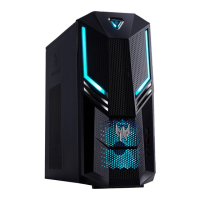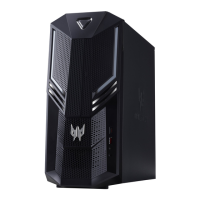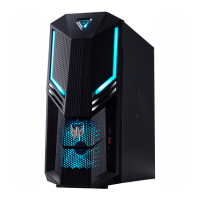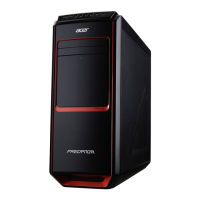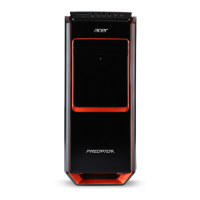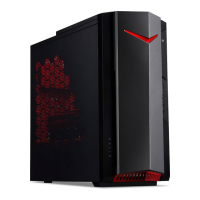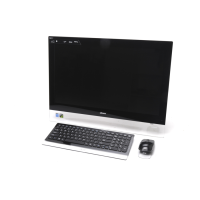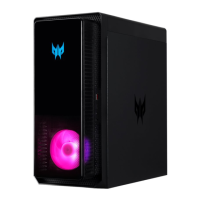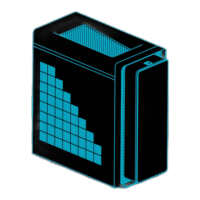Do you have a question about the Acer 6000 and is the answer not in the manual?
Provides details about the AcerPower 6000 system, its processors, memory, and features.
Explains the manual's structure, dividing it into four chapters covering system setup, board, BIOS, and components.
Covers site selection and unpacking of computer components before system setup.
Describes the basic configuration and front panel features of the AcerPower 6000 system.
Guides on connecting peripherals like keyboard, monitor, mouse, and printer to the system.
Step-by-step instructions for powering on the computer and its peripherals.
Procedures for properly shutting down the computer and peripherals.
Offers solutions for common hardware problems and general system failures.
Explains types of error messages and suggests corrective actions for system and software issues.
Details the key components and features of the AcerPower 6000 system board.
Illustrates and labels the locations of major components on the system board.
Explains the locations of jumpers and connectors on the system board.
Details configurable jumper settings for the system board.
Lists and describes the functions of onboard connectors on the system board.
Explains the IDE controller and hard disk configuration options.
Describes the onboard video controller capabilities and supported resolutions.
Details the onboard 3-D audio solution and audio connectors.
Explains the Universal Serial Bus standard and its implementation on the system.
Describes the system's hardware monitoring capabilities and software requirements.
Instructions on how to access and navigate the BIOS Setup utility.
Displays current system configuration details like processor, memory, and drives.
Provides system identification details such as product name and serial number.
Covers configuration settings for floppy drives, LS-120 drives, and IDE drives.
Details configuration options for serial ports, parallel ports, and other onboard devices.
Explains settings for managing system power consumption and sleep modes.
Allows configuration of boot sequence, drive priority, and fast boot settings.
Covers setting up passwords for BIOS access and system power-on.
Procedures for saving changes and exiting the BIOS utility.
Important safety and ESD precautions before installing system components.
Step-by-step guide on opening and closing the computer chassis.
Instructions for installing PCI and ISA expansion cards.
Details on how to install or upgrade system memory modules (DIMMs).
Guides on removing and installing processor cards (Pentium II, Celeron).
Provides details about the AcerPower 6000 system, its processors, memory, and features.
Explains the manual's structure, dividing it into four chapters covering system setup, board, BIOS, and components.
Covers site selection and unpacking of computer components before system setup.
Describes the basic configuration and front panel features of the AcerPower 6000 system.
Guides on connecting peripherals like keyboard, monitor, mouse, and printer to the system.
Step-by-step instructions for powering on the computer and its peripherals.
Procedures for properly shutting down the computer and peripherals.
Offers solutions for common hardware problems and general system failures.
Explains types of error messages and suggests corrective actions for system and software issues.
Details the key components and features of the AcerPower 6000 system board.
Illustrates and labels the locations of major components on the system board.
Explains the locations of jumpers and connectors on the system board.
Details configurable jumper settings for the system board.
Lists and describes the functions of onboard connectors on the system board.
Explains the IDE controller and hard disk configuration options.
Describes the onboard video controller capabilities and supported resolutions.
Details the onboard 3-D audio solution and audio connectors.
Explains the Universal Serial Bus standard and its implementation on the system.
Describes the system's hardware monitoring capabilities and software requirements.
Instructions on how to access and navigate the BIOS Setup utility.
Displays current system configuration details like processor, memory, and drives.
Provides system identification details such as product name and serial number.
Covers configuration settings for floppy drives, LS-120 drives, and IDE drives.
Details configuration options for serial ports, parallel ports, and other onboard devices.
Explains settings for managing system power consumption and sleep modes.
Allows configuration of boot sequence, drive priority, and fast boot settings.
Covers setting up passwords for BIOS access and system power-on.
Procedures for saving changes and exiting the BIOS utility.
Important safety and ESD precautions before installing system components.
Step-by-step guide on opening and closing the computer chassis.
Instructions for installing PCI and ISA expansion cards.
Details on how to install or upgrade system memory modules (DIMMs).
Guides on removing and installing processor cards (Pentium II, Celeron).
